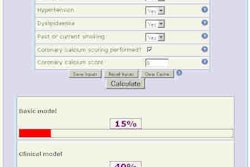An individual's total plaque burden at whole-body CT angiography (CTA) is a far more accurate predictor of cardiovascular risk than traditional risk-assessment measures, Italian researchers have discovered.
Among the findings from the University of Rome La Sapienza, only about one-fifth of patients who were classified as high risk under Framingham were also deemed high risk based on an atherosclerotic plaque burden score (ABS) derived from whole-body CTA.
Moreover, whole-body CTA predicted cardiovascular events over the next five years with accuracy of about 90% in high-risk patients versus about 70% for the Framingham risk index evaluation.
"As we all know, cardiovascular disease is a systemic and diffuse condition, and the presence of multiple locations [of disease burden] increases the one-year risk of cardiovascular events," said radiologist Dr. Fulvio Zaccagna in a presentation at the 2011 RSNA meeting. As a result, "Accurate assessment of atherosclerotic plaque burden -- its location, extent, and severity -- is mandatory for correct patient assessment."
Zaccagna and his University of Rome colleagues Drs. Allesandro Napoli, Michele Anzidei, Gaia Cartocci, Vicenzo Noce, and Carlo Catalano studied the prognostic value of whole-body CTA to determine if it might be superior to traditional risk stratification. They enrolled 341 patients between 2005 and 2007 and all patients completed follow-up after 65 months.
The 341 patients (mean age 63 ±10.4 years, range 34-89), all with cardiovascular risk factors ranging from metabolic syndrome to diabetes to smoking, underwent whole-body CTA on a 64-detector-row scanner (Somatom, Siemens Healthcare) using CareDose tube current modulation following a dual-phase injection of iodinated contrast material (Iomeprol 400, 400 mgI/mL; 70 + 50 mL at 4 mL/sec).
Following the first contrast injection, coronary CTA images were acquired using 64 x 0.6- mm slices, then the second bolus came 40 seconds later for the acquisition of whole-body CTA using 1-mm-thick slices, he noted.
The coronary arteries were divided into 15 segments (AHA model) to derive a total atherosclerotic burden score (ABS). The extracoronary arteries were divided into 32 segments, and all detected stenoses were graded using a 5-point scale (0-4 representing normal to occluded arteries; and 5, an aneurysm).
An ABS was generated for each patient and correlated to the Framingham Risk Index (FRI). Finally, the group compared ABS and FRI using Kaplan-Meier survival analysis, ROC analysis, and stepwise multivariable Cox proportional hazards regression models.
Based on the five-point scale, "We created classifications for low risk, mild risk and high risk," Zaccagna stated. "Under FRI, 58% of patients were classified as mild risk, and 42% as high-risk patients. But according to whole-body CTA-derived ABS, only about 20% of patients were classified as high risk, 11% mild risk, and 70% as low-risk patients," he said.
At baseline the mean ABS was 19.5±20.1 and the mean FRI was 12±10.7; 64.5 ± 11.3. Months after whole body CTA all patients were interviewed to assess health status.
At baseline ABS values were elevated in patients with hypertension in both the coronary and extracoronary vessels, he said. Meanwhile, patients with diabetes had greater plaque burden in the coronary vessels while patients with metabolic syndrome had greater plaque burden scores in the extracoronary vessels.
The prevalence of cardiovascular events was greater in patients with more than four cardiac risk factors, he said. During follow-up, 60% of patients had minor cardiac events, 31% had major cardiac events, and 2% died from cardiac-related accidents, he said.
The mean follow-up period was 50 months for higher-risk patients according to CT-derived ABS, and 52 months for patients deemed high-risk at FRI.
"There was a statistically significant difference [in the prevalence of cardiovascular events] between low-risk, mild-risk and high-risk patients according to whole-body CTA-derived ABS, meanwhile there was no significant risk according to Framingham risk for stratified patients," Zaccagna said.
- Kaplan-Meier curve showed a mean event-free time was of 62.3±2.4 months for patients with ABS under 10, 57.6±1.9 months for those with ABS < 20, with a statistically significant difference between low, mild and high risk (p=0.012).
- The mean event-free time was 57±5.6m for FRI mild-risk group and 52.5±4.2m for the high-risk group without significant differences between the two groups (p=0.072).
- For the prediction of cardiovascular events over the follow-up period in patients classified as high-risk, ABS' accuracy was 89% versus 69% at FRI (p=0.007).
- Multivariate analysis showed that only age (p=0.011), ABS score (p=0.000), and therapy (p=0.001) were independent predictors of "hard" cardiovascular events, according to Zaccagna.
Prognostic accuracy -- patient classification
|
Prognostic accuracy -- event prediction
|
|||||||||||||||||||||||||
Examples included a patient deemed at mild risk at Framingham who had complete occlusion of the right and left internal carotid arteries at whole-body CTA, and another patient at mild Framingham risk with extensive coronary artery disease. Still, the results showed that most patients at high Framingham risk were at mild risk by low-body CTA.
"Whole-body CT-derived ABS reflects actual atherosclerotic burden and provides superior risk stratification and event analysis with respect to FRI," he concluded. "Hard event prediction was significantly associated with age, ABS, and therapy but not to FRI."



















